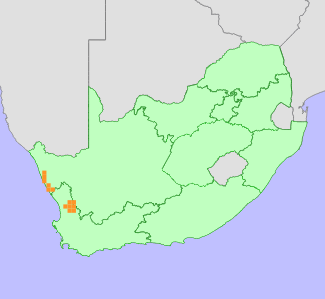|
Scientific Name | Leucospermum praemorsum (Meisn.) E.Phillips |
Higher Classification | Dicotyledons |
Family | PROTEACEAE |
Common Names | Kreupelhout (a), Luisiesbos (a), Nardouw Fountain Pincushion (e), Nardouw Pincushion (e), Nardouwluisiesbos (a), Nardouw-luisiesbos (a), Speldekussing (a) |
National Status |
Status and Criteria | Near Threatened B1b(ii,iii,v)+2b(ii,iii,v) |
Assessment Date | 2020/06/23 |
Assessor(s) | A.G. Rebelo, H. Mtshali & L. von Staden |
Justification | Leucospermum praemorsum has a restricted distribution range, with an Extent of Occurrence (EOO) of 13522-13551 km², and an Area of Occupancy (AOO) of 340-344 km². It is declining due to habitat loss and degradation over most of its range. Field observations however confirm that is still fairly common, remaining at between 19 and 27 locations, and therefore it nearly meets the thresholds for Vulnerable under criterion B and is listed as Near Threatened. |
Distribution |
Endemism | South African endemic |
Provincial distribution | Northern Cape, Western Cape |
Range | Leucospermum praemorsum is endemic to the Northern and Western Cape Provinces of South Africa, from Namaqualand to Cederberg Mountains. |
Habitat and Ecology |
Major system | Terrestrial |
Major habitats | Cederberg Sandstone Fynbos, Nardouw Sandstone Fynbos, Bokkeveld Sandstone Fynbos, Namaqualand Sand Fynbos |
Description | It occurs in arid sandstone fynbos, outside the Fynbos Biome this species occurs on the summits of linear dune systems. Mature individuals are killed by fires, and only seeds survive. Seeds are released after ripening, and dispersed by ants to their underground nests, where they are protected from predation and fire. It is pollinated by birds. |
Threats |
| This species has lost at 22% of its habitat to cereals and rooibos tea cultivation, particularly in Gifberg and Matsikammaberg. Large areas of fynbos on deep sandy, nutrient poor soils that previously have been unsuitable for cultivation have been ploughed up in the last 20 years.
Plants remain in isolated fragments that are continuing to decline due to overgrazing, too-infrequent fire due to fire exclusion management and groundwater extraction for irrigation. Global climate change is a potential threat. |
Population |
This species forms large subpopulations, of several thousand plants. However, a number of subpopulations remain in isolated fragments due to agriculture. There is ongoing decline of population due to habitat loss and degradation.
|
Population trend | Decreasing |
Assessment History |
Taxon assessed |
Status and Criteria |
Citation/Red List version | | Leucospermum praemorsum (Meisn.) E.Phillips | VU A2c | Raimondo et al. (2009) | |
Bibliography |
Goldblatt, P. and Manning, J.C. 2000. Cape Plants: A conspectus of the Cape Flora of South Africa. Strelitzia 9. National Botanical Institute, Cape Town.
Manning, J.C. and Goldblatt, P. 2012. Plants of the Greater Cape Floristic Region 1: The Core Cape Flora. Strelitzia 29. South African National Biodiversity Institute, Pretoria.
Raimondo, D., von Staden, L., Foden, W., Victor, J.E., Helme, N.A., Turner, R.C., Kamundi, D.A. and Manyama, P.A. 2009. Red List of South African Plants. Strelitzia 25. South African National Biodiversity Institute, Pretoria.
Rebelo, T. 2001. Sasol Proteas: A field guide to the proteas of southern Africa. (2nd ed.). Fernwood Press, Vlaeberg, Cape Town.
|
Citation |
| Rebelo, A.G., Mtshali, H. & von Staden, L. 2020. Leucospermum praemorsum (Meisn.) E.Phillips. National Assessment: Red List of South African Plants version . Accessed on 2025/04/13 |
 Comment on this assessment
Comment on this assessment

